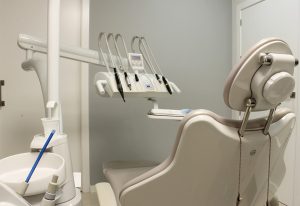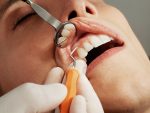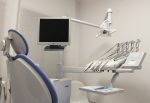
You are probably already familiar with what the main duty of a dental hygienist is, but we would like to describe it for those who may not know what these professionals do.
Their main responsibility is the prevention of disease and the promotion and improvement of the health of the public, as defined by the American Dental Hygienists Association (ADHA).
Dental hygienists perform various preventive procedures in a dental office.
Their duties include examining teeth and gums, determining the presence of disease or oral abnormality, removing calculus, stains, and plaque from the teeth, and applying fluorides and sealants.
There are some states that allow dental hygienists to administer anesthetics, remove sutures, and perform periodontal dressing duties.
As you could notice, the job duties and responsibilities of dental hygienists are quite numerous, so they need to be regulated.
By gaining a license in the state in which a candidate plans to practice a profession, he/she has proof of possessing the competencies necessary to perform this job.
State dental boards have set the rules that each candidate has to complete a dental assisting program at either the associate’s or bachelor’s degree level which has to be followed by successful completion of a national examination and a state/regional examination.
Page Navigation
The Joint Commission on National Dental Examinations
The National Board Dental Hygiene Examination (NBDHE) available through the Joint Commission on National Dental Examinations (JCNDE), an independent agency of the American Dental Association (ADA) is recognized by all U.S. jurisdictions and all 50 states.
This examination is used to determine the qualifications of dental hygienists who wish to gain licensure to practice their profession, meaning that it assesses some basic dental hygiene information, including biomedical, dental, and dental hygiene sciences.
Additionally, it assesses how the applicant applies his/her knowledge of dental hygiene in a problem-solving context.
NBDHE Examination Components
The NBDHE consists of 350 questions which are divided into two components.
Component A:
- Scientific Basis for Dental Hygiene Practice
- Anatomy
- Physiology
- Biochemistry and nutrition
- Microbiology and immunology
- Pathology
- pharmacology
- Provision of Clinical Dental Hygiene Services
- Assessing patient characteristics
- Obtaining and interpreting radiographs
- Planning and managing dental hygiene care
- Performing periodontal procedures
- Using preventive agents
- Providing supportive treatment services
- Professional responsibility
- Community Health/Research Principles
- Promoting health and preventing disease within groups
- Participating in community programs
- Analyzing scientific literature, applying research results, and understanding statistical concepts
Component B:
- 150 case-based items that refer to 12 to 15 dental hygiene patient case, which address the following:
- Obtaining/interpreting radiographs
- Using preventive agents
- Professional responsibility
- Planning and managing dental hygiene care
- Assessing patient characteristics
- Providing supportive treatment services
It is highly recommended that textbooks and lecture notes are used as sources for study for this examination.
Taking the NCDBE
The NCDBE is administered through Pearson VUE testing centers, and it is highly suggested that interested candidates should take a look at the offered tutorial through Pearson VUE before taking the actual examination.
The cost of taking the NBDHE is $400.
The score that can be achieved ranges from 49 to 99 and a score of 75 represents the minimum, passing score that an applicant has to reach so as to be given a license.
Candidates will get a pass/fail notification after about three weeks’ time.
Those who do not pass the exam are given a numerical score and are allowed to reapply for examination after 90 days.
In case a candidate does not pass the examination after 3 attempts, he/she is required to wait 12 months after the third attempt before he/she is allowed to reapply.
The JCNDE has set a rule according to which candidates must pass the examination within 5 years of their first attempt or within 5 examination attempts.
Those who think they are ready for the NBDHE should apply through JCNDE and if they meet the eligibility requirements, their application eligibility will be forwarded to Pearson VUE.
Then, they will receive an email from JCNDE which will contain testing appointment scheduling instructions.
A candidate must take the NBDHE in a six-month period from the moment his/her application has been processed by JCNDE.
Eligibility Requirements to Sit for the NBDHE
Not every person is allowed to take the NBDHE and in order to qualify for it, you must meet at least ONE of the following requirements:
- Taking the examination is allowed to a graduate of a dental hygiene program that was accredited by the Commission on Dental Accreditation (CODA); OR
- A current dental hygiene student in a CODA-accredited program who received certification from the director that is prepared in all NBDHE disciplines; OR
- A graduate of a non-accredited dental hygiene program but has a letter of recommendation from the dean of an accredited dental school or the director of an accredited dental hygiene program, as well as the secretary of a board of dentistry of a U.S. licensing jurisdiction in which it is certified that the non-accredited program meets all examination requirements, including study, subjects, and hours.
State/Regional Examination for Licensure
You should know that the successful completion of the NBDHE is not the end of your testing as, candidates for state licensure are usually required to take and pass a clinical (practical examination), so as to prove that they are able to provide a reliable clinical treatment of a patient.
These examinations differ, but the majority of them consist of skill-specific patient treatment in a clinical setting.
There are some examinations that also include a written or electronic patient-based component.
There are a few states which require state-specific clinical examinations.
However, the majority of states will accept one of the five regional testing agencies:
- Western Regional Examining Board (WREB)
- Southern Regional Testing Agency (SRTA)
- North East Regional Board (NERB) of Dental Examiners
- Council of Interstate Testing Agencies (CITA)
- Central Regional Dental Testing Services (CRDTS)
You will find out that certain states require that you as a future dental hygienist complete a specific examination, while some other states recognize the completion of more than one examination for licensure as a dental hygienist.








